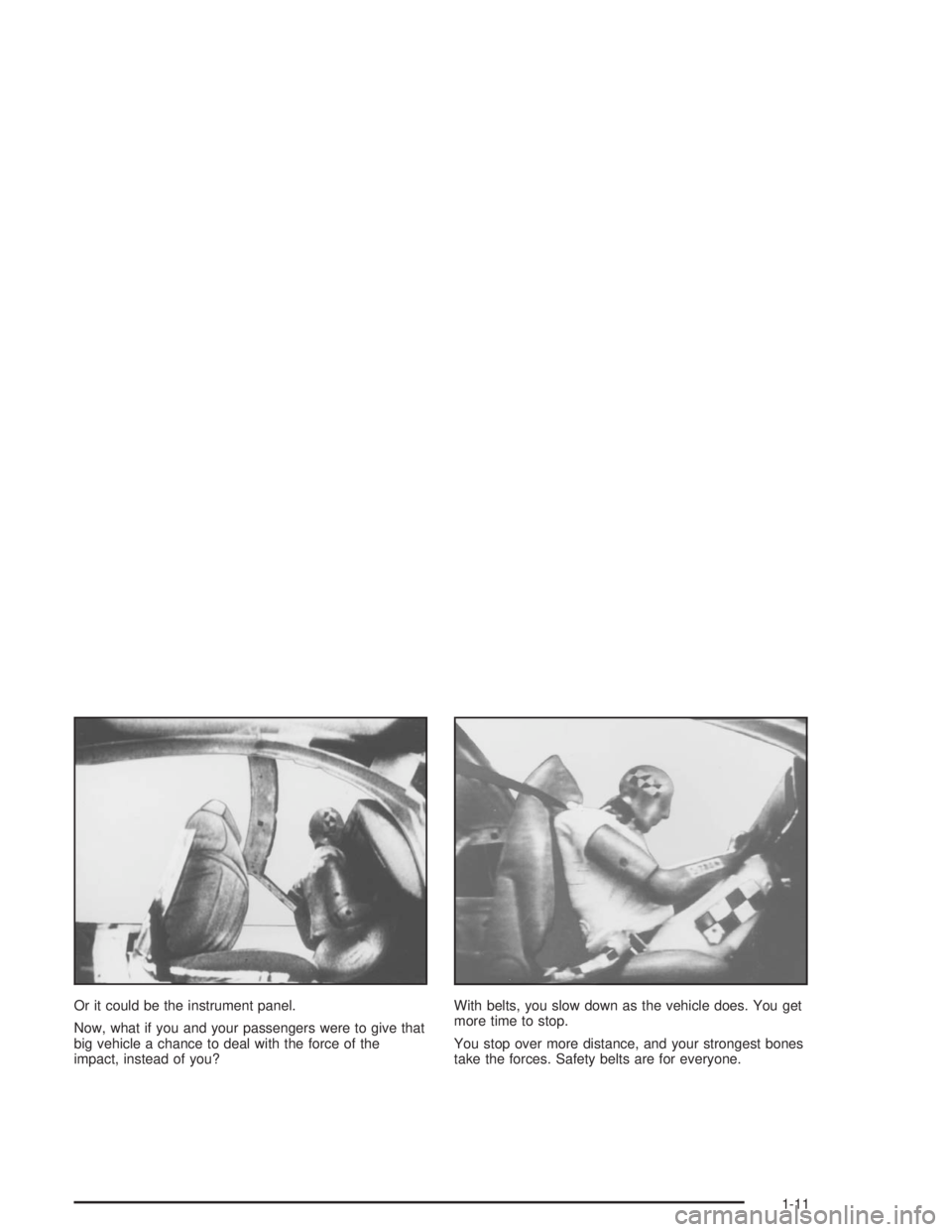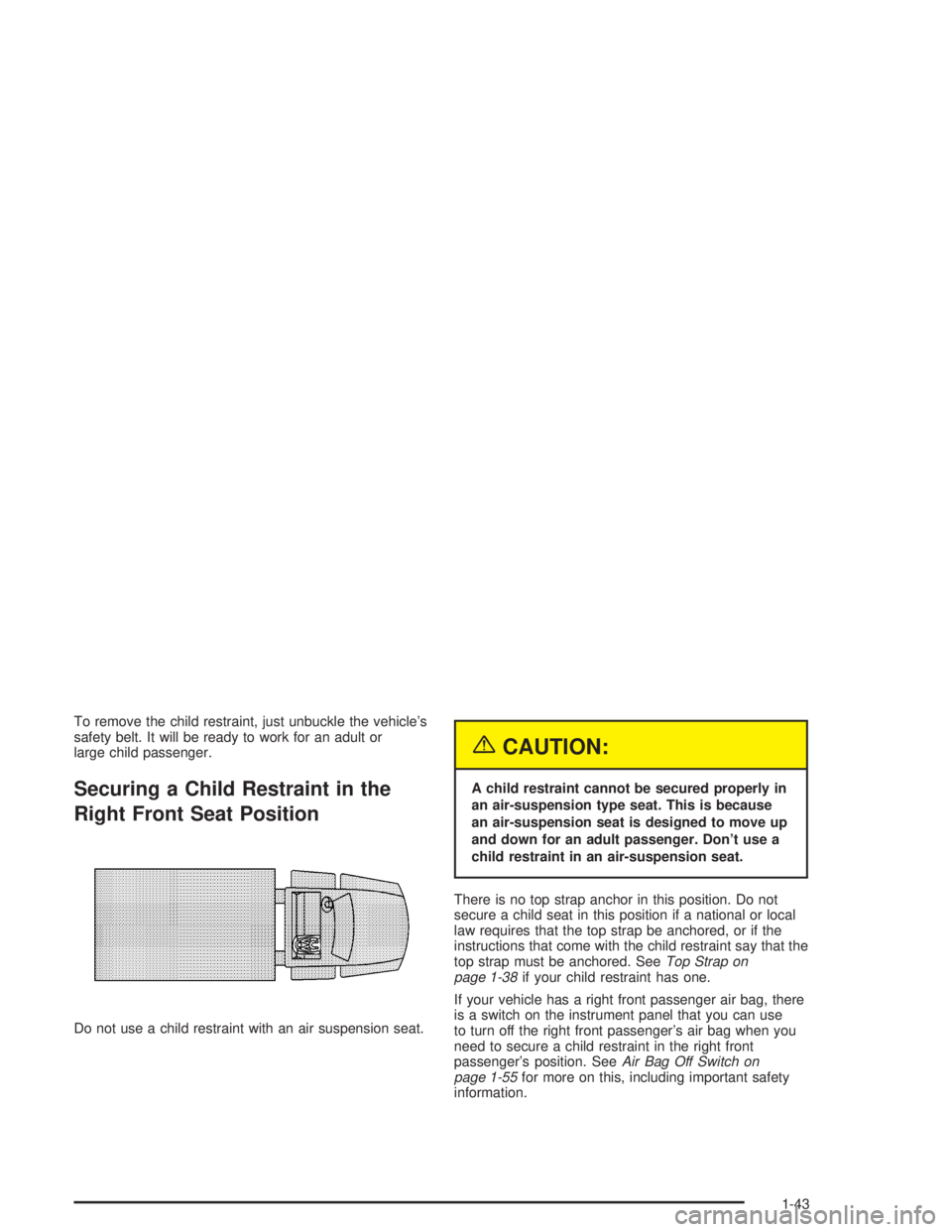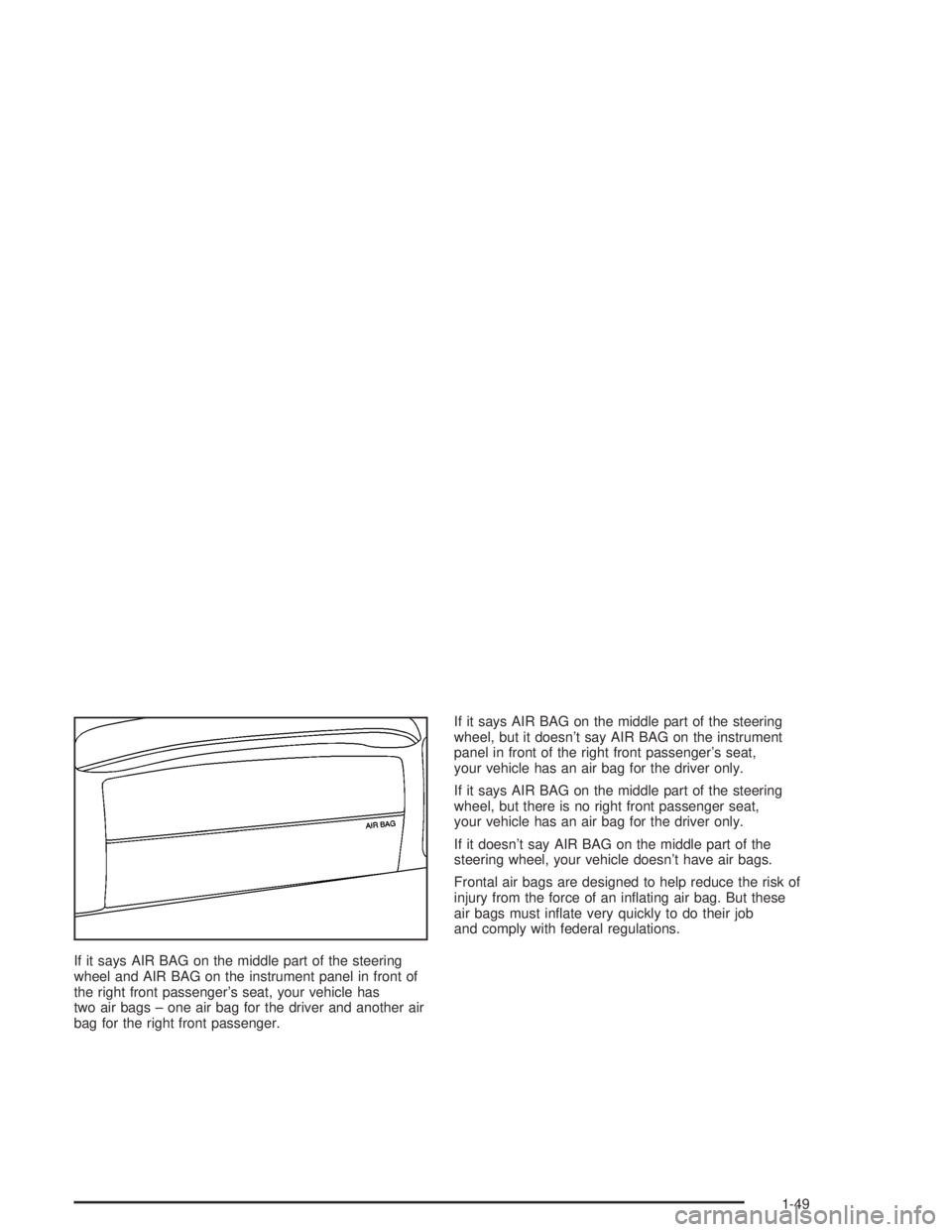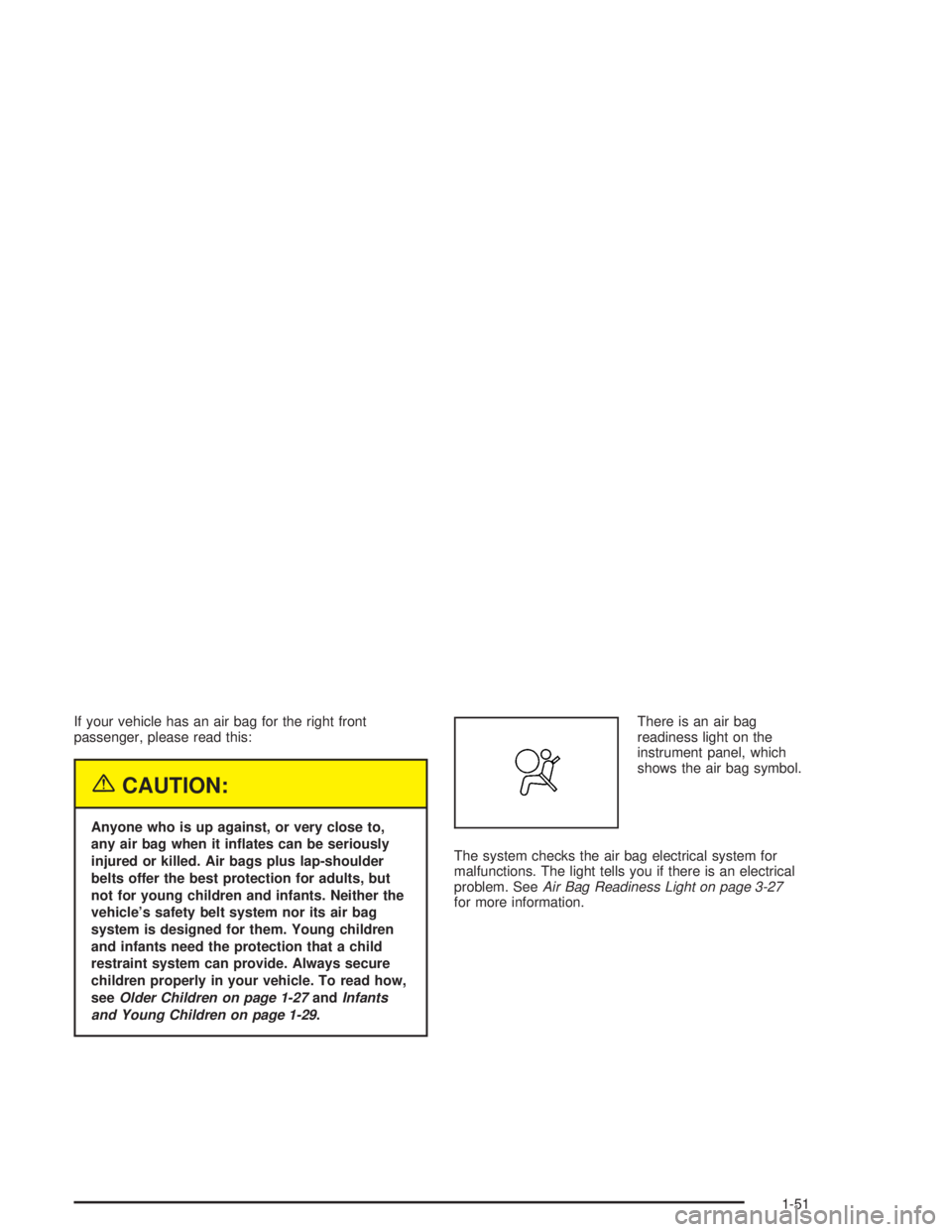2004 CHEVROLET KODIAK instrument panel
[x] Cancel search: instrument panelPage 1 of 366

Seats and Restraint Systems........................... 1-1
Front Seats
............................................... 1-2
Rear Seats
............................................... 1-7
Safety Belts
.............................................. 1-8
Child Restraints
.......................................1-27
Air Bag System
.......................................1-48
Restraint System Check
............................1-61
Features and Controls..................................... 2-1
Keys
........................................................ 2-2
Doors and Locks
....................................... 2-6
Windows
.................................................. 2-8
Theft-Deterrent Systems
............................2-10
Starting and Operating Your Vehicle
...........2-11
Mirrors
....................................................2-39
Storage Areas
.........................................2-41
Instrument Panel............................................. 3-1
Instrument Panel Overview
.......................... 3-4
Climate Controls
......................................3-19
Warning Lights, Gages, and Indicators
........3-23
Audio System(s)
.......................................3-45
Driving Your Vehicle....................................... 4-1
Your Driving, the Road, and Your Vehicle
..... 4-2
Towing
...................................................4-31Service and Appearance Care.......................... 5-1
Service
..................................................... 5-3
Fuel
......................................................... 5-6
Checking Things Under the Hood
...............5-18
Rear Axle
...............................................5-61
Noise Control System
...............................5-62
Bulb Replacement
....................................5-63
Windshield Wiper Blade Replacement
.........5-63
Other Service Items
..................................5-64
Tires
......................................................5-68
Appearance Care
.....................................5-76
Vehicle Identification
.................................5-85
Electrical System
......................................5-86
Capacities and Specifications
.....................5-93
Normal Maintenance Replacement Parts
....5-100
Maintenance Schedule..................................... 6-1
Maintenance Schedule
................................ 6-2
Customer Assistance and Information.............. 7-1
Customer Assistance and Information
........... 7-2
Reporting Safety Defects
............................ 7-6
Index.................................................................1
2004 Chevrolet Kodiak Owner ManualM
Page 4 of 366

Vehicle Damage Warnings
Also, in this book you will find these notices:
Notice:These mean there is something that could
damage your vehicle.
A notice will tell you about something that can damage
your vehicle. Many times, this damage would not be
covered by your warranty, and it could be costly. But the
notice will tell you what to do to help avoid the
damage.
When you read other manuals, you might see
CAUTION and NOTICE warnings in different colors
or in different words.
You’ll also see warning labels on your vehicle. They use
the same words, CAUTION or NOTICE.
Vehicle Symbols
Your vehicle has components and labels that use
symbols instead of text. Symbols, used on your vehicle,
are shown along with the text describing the operation
or information relating to a specific component, control,
message, gage or indicator.
If you need help figuring out a specific name of a
component, gage or indicator, reference the following
topics:
•Seats and Restraint Systems in Section 1
•Features and Controls in Section 2
•Instrument Panel Overview in Section 3
•Climate Controls in Section 3
•Warning Lights, Gages and Indicators in Section 3
•Audio System(s) in Section 3
•Engine Compartment Overview in Section 5
iv
Page 17 of 366

Or it could be the instrument panel.
Now, what if you and your passengers were to give that
big vehicle a chance to deal with the force of the
impact, instead of you?With belts, you slow down as the vehicle does. You get
more time to stop.
You stop over more distance, and your strongest bones
take the forces. Safety belts are for everyone.
1-11
Page 42 of 366

{CAUTION:
A child restraint cannot be secured properly in
an air-suspension type seat. This is because
an air-suspension seat is designed to move up
and down for an adult passenger. Don’t use a
child restraint in an air-suspension seat.
If your vehicle is a regular cab model with a static seat
in the right front passenger’s position, or if it has a
bench seat, the child restraint must be secured properly
in the right front passenger’s seat. If your vehicle has
air bags and you need to secure a child restraint in the
right front passenger’s seat, there is a switch on the
instrument panel that you can use to turn off the
passenger’s air bag. SeeAir Bag Off Switch on
page 1-55andSecuring a Child Restraint in the Right
Front Seat Position on page 1-43for more on this,
including important safety information.
Unless the passenger’s air bag has been turned off,
never put a rear-facing child restraint in this vehicle.
Here is why:
{CAUTION:
A child in a rear-facing child restraint can be
seriously injured or killed if the passenger’s air
bag in�ates. This is because the back of the
rear-facing child restraint would be very close
to the in�ating air bag. Do not use a
rear-facing child restraint in this vehicle unless
the passenger’s air bag has been turned off.
Even though the air bag off switch is designed
to turn off the passenger’s frontal air bag, no
system is fail-safe, and no one can guarantee
that an air bag will not deploy under some
unusual circumstance, even though it is turned
off. We recommend that rear-facing child
restraints be transported in vehicles with a
rear seat that will accommodate a rear-facing
child restraint, whenever possible.
If you secure a forward-facing child restraint in
the right front static seat or right front bench
seat, always move the passenger seat as far
back as it will go.
Keep in mind that an unsecured child restraint can
move around in a collision or sudden stop and injure
people in the vehicle – even when no child is in it.
1-36
Page 43 of 366

Where to Put the Restraint
(Crew Cab Models)
Accident statistics show that children are safer if they
are restrained in the rear rather than the front seat. We
recommend that child restraints be secured in a rear
seat position, including an infant riding in a rear-racing
infant seat, a child riding in a forward-facing child
seat and an older child riding in a booster seat.
If your vehicle has air bags and you need to secure a
child restraint in the right front passenger’s seat, there is
a switch on the instrument panel that you can use to
turn off the passenger’s air bag. SeeAir Bag Off Switch
on page 1-55andSecuring a Child Restraint in the
Right Front Seat Position on page 1-43for more on this,
including important safety information.
Unless the passenger’s air bag has been turned off,
never put a rear-facing child restraint in the right front
seat position. Here is why:
{CAUTION:
A child in a rear-facing child restraint can be
seriously injured or killed if the right front
passenger’s air bag in�ates. This is because
the back of the rear-facing child restraint
would be very close to the in�ating air bag. Be
sure to turn off the air bag before using a
rear-facing child restraint in the right front seat
position.
Even though the air bag off switch is designed
to turn off the passenger’s air bag, no system
is fail-safe, and no one can guarantee that an
air bag will not deploy under some unusual
circumstance, even though it is turned off.
General Motors recommends that rear-facing
child restraints be secured in the rear seat,
even if the air bag is off.
If your secure a forward-facing child restraint
in the right front static seat or right front
bench seat, always move the front passenger
seat as far back as it will go. It is better to
secure the child restraint in a rear seat.
1-37
Page 49 of 366

To remove the child restraint, just unbuckle the vehicle’s
safety belt. It will be ready to work for an adult or
large child passenger.
Securing a Child Restraint in the
Right Front Seat Position
Do not use a child restraint with an air suspension seat.
{CAUTION:
A child restraint cannot be secured properly in
an air-suspension type seat. This is because
an air-suspension seat is designed to move up
and down for an adult passenger. Don’t use a
child restraint in an air-suspension seat.
There is no top strap anchor in this position. Do not
secure a child seat in this position if a national or local
law requires that the top strap be anchored, or if the
instructions that come with the child restraint say that the
top strap must be anchored. SeeTop Strap on
page 1-38if your child restraint has one.
If your vehicle has a right front passenger air bag, there
is a switch on the instrument panel that you can use
to turn off the right front passenger’s air bag when you
need to secure a child restraint in the right front
passenger’s position. SeeAir Bag Off Switch on
page 1-55for more on this, including important safety
information.
1-43
Page 55 of 366

If it says AIR BAG on the middle part of the steering
wheel and AIR BAG on the instrument panel in front of
the right front passenger’s seat, your vehicle has
two air bags – one air bag for the driver and another air
bag for the right front passenger.If it says AIR BAG on the middle part of the steering
wheel, but it doesn’t say AIR BAG on the instrument
panel in front of the right front passenger’s seat,
your vehicle has an air bag for the driver only.
If it says AIR BAG on the middle part of the steering
wheel, but there is no right front passenger seat,
your vehicle has an air bag for the driver only.
If it doesn’t say AIR BAG on the middle part of the
steering wheel, your vehicle doesn’t have air bags.
Frontal air bags are designed to help reduce the risk of
injury from the force of an inflating air bag. But these
air bags must inflate very quickly to do their job
and comply with federal regulations.
1-49
Page 57 of 366

If your vehicle has an air bag for the right front
passenger, please read this:
{CAUTION:
Anyone who is up against, or very close to,
any air bag when it in�ates can be seriously
injured or killed. Air bags plus lap-shoulder
belts offer the best protection for adults, but
not for young children and infants. Neither the
vehicle’s safety belt system nor its air bag
system is designed for them. Young children
and infants need the protection that a child
restraint system can provide. Always secure
children properly in your vehicle. To read how,
seeOlder Children on page 1-27andInfants
and Young Children on page 1-29.There is an air bag
readiness light on the
instrument panel, which
shows the air bag symbol.
The system checks the air bag electrical system for
malfunctions. The light tells you if there is an electrical
problem. SeeAir Bag Readiness Light on page 3-27
for more information.
1-51